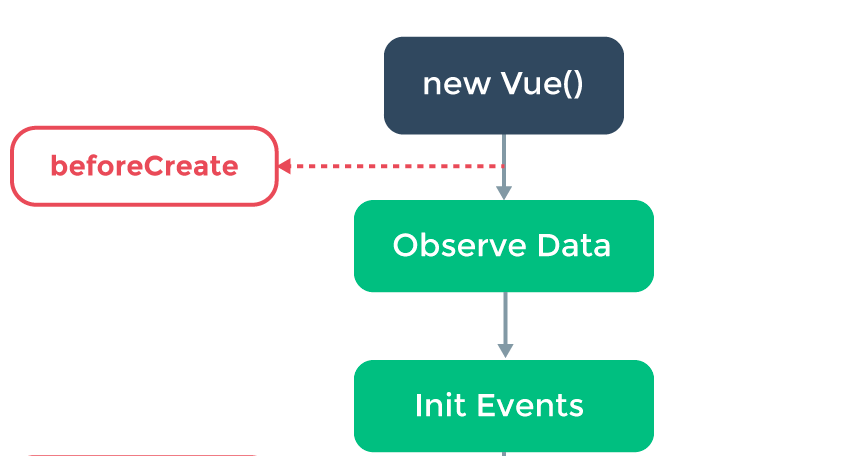最近在写业务的时候,总是会遇到一些和vue的生命周期相关的问题,比如: 你用ajax请求数据,然后将数据props到子组件的时候,因为ajax是异步的,然后会发生没有数据。然后查找原因还是自己对这个东西理解不够深入。
什么是生命周期函数?
比如:
mounted: function() {
}
// 或者
mounted() {
}- 注意点,Vue的所有生命周期函数都是自动绑定到this的上下文上。所以,你这里使用箭头函数的话,就会出现this指向的父级作用域,就会报错。
错误的形式:
mounted:() => {
}
实例初始化——new Vue()
数据观测——在vue的响应式系统中加入data对象中所有数据,这边涉及到vue的双向绑定,可以看官方文档上的这篇深度响应式原理 深度响应式原理
暴露属性和方法——就是vue实例自带的一些属性和方法,我们可以看一个官网的例子,例子中带$的属性和方法就是vue实例自带的,可以和用户定义的区分开来
var data = { a: 1 }
var vm = new Vue({
el: '#example',
data: data
})
vm.$data === data // => true
vm.$el === document.getElementById('example') // => true
// $watch 是一个实例方法
vm.$watch('a', function (newValue, oldValue) {
// 这个回调将在 `vm.a` 改变后调用
})- el属性对生命周期的影响
// 有el属性的情况下
new Vue({
el: '#app',
beforeCreate: function() {
console.log('调用了beforeCreate')
},
created: function() {
console.log('调用了created')
},
beforeMount: function() {
console.log('调用了beforeMount')
},
mounted: function() {
console.log('调用了mounted')
}
})
// 输出结果
// 调用了beforeCreate
// 调用了created
// 调用了beforeMount
// 调用了mounted// 在没有el属性的情况下,没有vm.$mount
new Vue({
beforeCreate: function() {
console.log('调用了beforeCreate')
},
created: function() {
console.log('调用了created')
},
beforeMount: function() {
console.log('调用了beforeMount')
},
mounted: function() {
console.log('调用了mounted')
}
})
// 输出结果
// 调用了beforeCreate
// 调用了created// 在没有el属性的情况下,但是有vm.$mount方法
var vm = new Vue({
beforeCreate: function() {
console.log('调用了beforeCreate')
},
created: function() {
console.log('调用了created')
},
beforeMount: function() {
console.log('调用了beforeMount')
},
mounted: function() {
console.log('调用了mounted')
}
})
vm.$mount('#app')
// 输出结果
// 调用了beforeCreate
// 调用了created
// 调用了beforeMount
// 调用了mounted- template属性对生命周期的影响
这里面分三种情况:
1、在实例内部有template属性的时候,直接用内部的,然后调用render函数去渲染。 2、在实例内部没有找到template,就调用外部的html。实例内部的template属性比外部的优先级高。 3、要是前两者都不满足,那么就抛出错误。
我们来看以下几个例子:
new Vue({
el: '#app',
template: '<div id="app">hello world</div>'
})
//页面上渲染出了hello world<div id="app">hello world</div>
new Vue({
el: '#app'
})
// 页面上渲染出了hello world
//两者都存在的时候
<div id="app">hello world2</div>
new Vue({
el: '#app',
template: '<div id="app">hello world1</div>'
})
// 页面上渲染出了hello world1
从上述的例子可以看出内部的优先外部的。
- 关于这个生命周期中的一些问题:
1、为什么el属性的判断在template之前? 因为el是一个选择器,比如上述例子中我们用到的最多的是id选择器app,vue实例需要用这个el去template中寻找对应的。
2、实际上,vue实例中还有一种render选项,我们可以从文档上看一下他的用法:
new Vue({
el: '#app',
render() {
return (...)
}
})3、上述三者的渲染优先级:render函数 > template属性 > 外部html
4、vue编译过程——把tempalte编译成render函数的过程。
我们先来看一个例子:
<div id="app">
<p>{{message}}</p>
</div>
new Vue({
el: '#app',
data: {
message: 1
},
beforeMount: function() {
console.log('调用了beforeMount');
console.log(this.message)
console.log(this.$el)
},
mounted: function() {
console.log('调用了mounted');
console.log(this.message)
console.log(this.$el)
}
})
// 输出的结果:
// 调用了beforeMount
// 1
// <div>
// </div>
// 调用了mounted
// 1
// <div id="app">
// <p>1</p>
// </div>
创建vue实例的$el,然后用它替代el属性。
这个过程中,我们会发现,当一个数据发生改变时,你的视图也将随之改变,整个更新的过程是:数据改变——导致虚拟DOM的改变——调用这两个生命钩子去改变视图
- 重点:这个数据只有和模版中的数据绑定了才会发生更新。
// 没绑定的情况
var vm = new Vue({
el: '#app',
template: '<div id="app"></div>',
beforeUpdate: function() {
console.log('调用了beforeUpdate')
},
updated: function() {
console.log('调用了uodated')
},
data: {
a: 1
}
})
vm.a = 2
//这种情况在控制台中是什么都不会输出的。var vm = new Vue({
el: '#app',
template: '<div id="app">{{a}}</div>',
beforeUpdate: function() {
console.log('调用了beforeUpdate')
},
updated: function() {
console.log('调用了uodated')
},
data: {
a: 1
}
})
vm.a = 2
// 输出结果:
// 调用了beforeUpdate
// 调用了uodated在beferoDestory生命钩子调用之前,所有实例都可以用,但是当调用后,Vue 实例指示的所有东西都会解绑定,所有的事件监听器会被移除,所有的子实例也会被销毁。
- activated:当组件激活的时候调用
- deactivated:当组件停用的时候调用
- errorCaptured:这个生命钩子可以看官网,2.5.0之后才有的。当捕获一个来自子孙组件的错误时被调用。
let vm = new Vue({
el: '#app',
data: {
message: 1
},
template: '<div id="app"><p>{{message}}</p></div>',
beforeCreate() {
console.log('调用了beforeCreate')
console.log(this.message)
console.log(this.$el)
},
created() {
console.log('调用了created')
console.log(this.message)
console.log(this.$el)
},
beforeMount() {
console.log('调用了beforeMount')
console.log(this.message)
console.log(this.$el)
},
mounted() {
console.log('调用了mounted')
console.log(this.message)
console.log(this.$el)
},
beforeUpdate() {
console.log('调用了beforeUpdate')
console.log(this.message)
console.log(this.$el)
},
updated() {
console.log('调用了updated')
console.log(this.message)
console.log(this.$el)
},
beforeDestory() {
console.log('调用了beforeDestory')
console.log(this.message)
console.log(this.$el)
},
destoryed() {
console.log('调用了Destoryed')
console.log(this.message)
console.log(this.$el)
}
})
vm.message = 2
- 输出的结果:
// 调用了beforeCreate
// undefined
// undefined
// 调用了created
// 1
// undefined
// 调用了beforeMount
// 1
// <div></div>
// 调用了mounted
// 1
// <div id="app"><p>1</p></div>
// 调用了beforeUpdate
// 2
// <div id="app"><p>2</p></div>
// 调用了updated
// 2
// <div id="app"><p>2</p></div>




